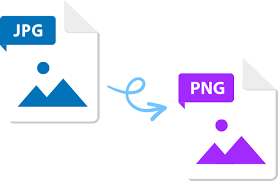
In the digital age, images play a crucial role in capturing attention and conveying information. While JPG (Joint Photographic Experts Group) format reigns supreme for photographs due to its efficient compression, PNG (Portable Network Graphic) offers unique advantages that can significantly enhance certain types of digital content. Understanding the strengths of each format and strategically converting JPG to PNG can unlock hidden potential and elevate your visual content to new heights.
Diving into the Strengths of PNG:
- Lossless Compression: Unlike JPG, which employs lossy compression that discards some image data, PNG utilizes a lossless compression method. This means that PNG images retain all their original data, resulting in pixel-perfect preservation of details, sharp edges, and text.
- Transparency: PNG excels at handling transparency, allowing you to create images with transparent backgrounds. This feature is invaluable for logos, icons, web graphics, and overlays, enabling seamless integration into various digital designs.
- Color Accuracy: PNG supports a wider color palette than JPG, ensuring vibrant and accurate color reproduction, particularly crucial for infographics, illustrations, and design elements.
When to Consider Converting JPG to PNG:
- Logos and Icons: PNG’s transparency feature makes it the ideal format for logos, icons, and other design elements that require seamless integration into different backgrounds.
- Infographics and Charts: The crisp lines, sharp text, and color accuracy of PNG are essential for infographics, charts, and other data-driven visuals.
- Web Graphics and Overlays: PNG’s transparency allows for the creation of overlays, website elements, and other web graphics that seamlessly blend with the background design.
- Illustrations and Design Elements: When precise details and color accuracy are paramount, PNG is the preferred format for illustrations, vector graphics, and design elements.
Conclusion: A Strategic Approach for Enhanced Visuals
While JPG remains the go-to format for photographs due to its smaller file size, strategically convert online JPG to PNG unlocks a range of benefits for specific digital content applications. By leveraging the strengths of PNG, you can achieve:
- Enhanced Visual Clarity: Preserve sharp edges, text, and intricate details with lossless compression.
- Seamless Integration: Utilize transparency to create visually compelling overlays and design elements.
- Accurate Color Representation: Ensure vibrant and precise color reproduction for impactful visuals.
Remember, choosing the right format depends on the specific needs of your digital content. By understanding the strengths of both JPG and PNG, you can make informed decisions and unlock the full potential of your visuals.
FAQs:
- Are there any drawbacks to using PNG? PNG files can be significantly larger than JPGs due to their lossless compression. This might not be ideal for photographs where slight quality loss is acceptable in exchange for smaller file sizes.
- How can I convert JPG images to PNG? Numerous online tools, free software, and even photo editing applications offer simple conversion options for transforming JPG images to PNG.
- Does converting JPG to PNG affect the image quality? Converting from JPG to PNG preserves the original image quality, as PNG utilizes lossless compression. However, the initial quality of the JPG image will determine the final quality of the PNG version.







